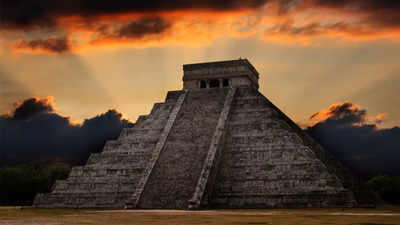Trending
The interesting story of Maya civilization and its dead rulers
At Ucanal, Guatemala, researchers, led by Dr. Christina T. Halperin, unveiled a Mayan political ritual involving burnt royal remains. This "fire-entering rite" symbolized regime shifts, supported by radiocarbon dating placing the event between AD 773 and 881. Witnessed by locals, it signifies Maya's active engagement in political transformation, emphasizing their dynamic political landscape and symbolic transition between ruling dynasties.

The ancient Maya civilization had a unique ritual that they performed to mark the beginning of a new dynasty. Source: Canva
The ancient Maya civilization, known for its sophisticated culture, intricate calendar system, and monumental architecture, also had complex political rituals. One such ritual has recently come to light through the discovery by researchers that the Maya marked the transition to a new dynasty by burning the remains of their deceased rulers. This practice was unearthed in the foundations of a Maya temple, where the charred bones of royal individuals were found, suggesting a fiery ritual that symbolized the end of one era and the beginning of another.
The discovery was made at the archaeological site of Ucanal, located in present-day Guatemala.The researchers, led by Dr. Christina T. Halperin from the University of Montreal, found the remains mixed with rocks beneath a pyramid temple structure. The deposit contained the bones of at least four individuals, along with thousands of ornamental fragments and beads. The bones of two individuals and many of the ornaments showed evidence of burning at high temperatures.
The significance of this find is profound, as it provides physical evidence of a ritual known as the “fire-entering rite.” This rite was a dramatic marker of political change, venerating the past while simultaneously destroying its symbols to make way for the new leadership. The timing of the burning corresponds with the rise of a new leader at Ucanal named Papmalil, who was possibly an outsider and came to power amid a wider unraveling of Maya society.
Radiocarbon dating indicates that at least one individual had died up to a century before the remains were burned between AD 773 and 881. This suggests that the bones were exhumed from a previous burial and then subjected to ritual burning. Such an act would have been a public and ceremonial display of political defiance or renewal, witnessed by the local populace.

The ritual burning of royal remains
The discovery at Ucanal also coincided with architectural changes where elite buildings were dismantled and repurposed, further emphasizing the dramatic overhaul of the social and political order. The burning of the royal remains was emblematic of broader shifts in Maya society during this turbulent period, reflecting a symbolic reinterpretation and social transformation that was taking place.
This event, therefore, represented the ever-evolving and often tumultuous nature of Maya political life. It highlights the lengths to which the Maya went to legitimize new power structures and to ceremonially mark the passage from one ruling dynasty to another. The ritual burning of the dead rulers was a powerful statement of change, a physical manifestation of the end of one chapter in Maya history and the beginning of another.
The discovery was made at the archaeological site of Ucanal, located in present-day Guatemala.The researchers, led by Dr. Christina T. Halperin from the University of Montreal, found the remains mixed with rocks beneath a pyramid temple structure. The deposit contained the bones of at least four individuals, along with thousands of ornamental fragments and beads. The bones of two individuals and many of the ornaments showed evidence of burning at high temperatures.
The significance of this find is profound, as it provides physical evidence of a ritual known as the “fire-entering rite.” This rite was a dramatic marker of political change, venerating the past while simultaneously destroying its symbols to make way for the new leadership. The timing of the burning corresponds with the rise of a new leader at Ucanal named Papmalil, who was possibly an outsider and came to power amid a wider unraveling of Maya society.
Radiocarbon dating indicates that at least one individual had died up to a century before the remains were burned between AD 773 and 881. This suggests that the bones were exhumed from a previous burial and then subjected to ritual burning. Such an act would have been a public and ceremonial display of political defiance or renewal, witnessed by the local populace.
The items discovered alongside the remains, including a greenstone mask and jade ornaments, were typically linked with Maya royalty. This suggests the elevated status of the individuals whose remains were cremated. The burning, possibly witnessed by locals, wasn't just a farewell to former leaders but a calculated act symbolizing the transition to a new era under different governance.

The jade ornaments found by Dr Christina T. Halperin and her team on the site. Jade ornaments were often a mark of royalty. Source: Christina T. Halperin
The ritual burning of royal remains
to mark a regime change is a rare moment where such transitions are visible in the archaeological record. It adds a vivid chapter to our understanding of Maya political dramas and the ways in which they actively engaged in reshaping their political landscapes. This period, fraught with dynastic collapses and realignments, saw the Maya not merely witnessing their decline towards the end of the Classic period but actively participating in the creation of a new political order.
The discovery at Ucanal also coincided with architectural changes where elite buildings were dismantled and repurposed, further emphasizing the dramatic overhaul of the social and political order. The burning of the royal remains was emblematic of broader shifts in Maya society during this turbulent period, reflecting a symbolic reinterpretation and social transformation that was taking place.
This event, therefore, represented the ever-evolving and often tumultuous nature of Maya political life. It highlights the lengths to which the Maya went to legitimize new power structures and to ceremonially mark the passage from one ruling dynasty to another. The ritual burning of the dead rulers was a powerful statement of change, a physical manifestation of the end of one chapter in Maya history and the beginning of another.
Ranveer Singh Deepfake video case: Maharashtra Police take legal action against netizen for uploading actor's AI-generated video allegedly endorsing a political party
End of Article
FOLLOW US ON SOCIAL MEDIA









